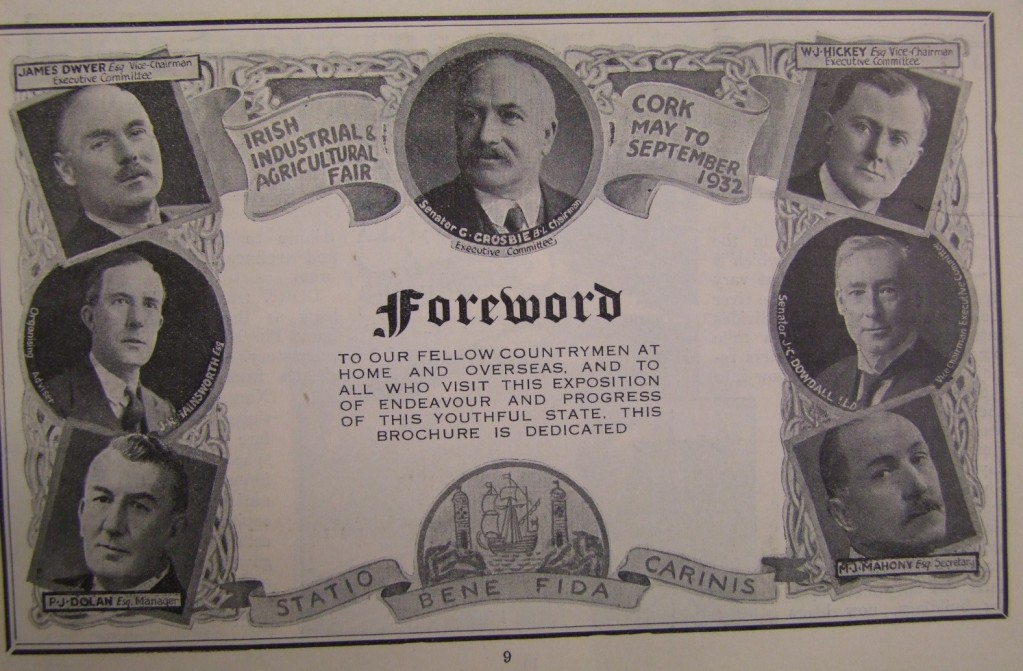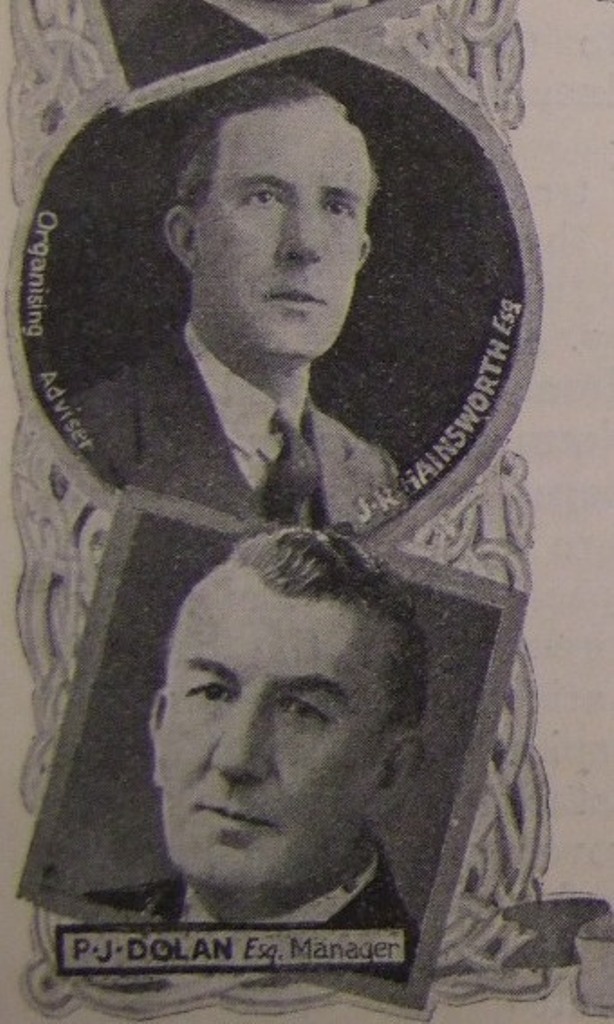
Kieran’s Our City, Our Town article, Cork Independent,
11 November 2010
In the Footsteps of St. Finbarre (Part 236)
Building an Irish Affair
President of the Executive Council (head of government) of the Irish Free State William T. Cosgrave visited Cork in the first week of October 1931 and cut the first sod for the buildings of the Irish Industrial and Agricultural Fair.
Two well known Corkmen were engaged as manager and secretary respectively, namely Mr. P.J. Dolan and Mr. M.J. Mahony. The fair committee also secured the services of Mr. J. Hainsworth as organising adviser who had over 18 years experience of exhibition organisation . He had been assistant manager of the Newcastle-upon-Tyne Exhibition in 1929. A prospectus was written up and circulated looking for interested exhibitors. Applications for space for exhibits had to made on official printed forms, which were to supplied on application to the manager. All particulars of exhibits had to be clearly stated and the forms returned to the manager. No article, which had not been described in the application form, was to be allowed to be exhibited without the sanction of the fair committee. The charge for floor space in the ‘Palace of Industries’ and other exhibit buildings was at a rate of 7/ and 10/- per square foot. Exhibitors had to pay all expenses of conveying, delivering, arranging, fixing, and removing their exhibits. They had to personally or by representative, superintend the transport, reception and unpacking of their goods. Exhibitors were allowed to sell articles manufactured by them at the fair.
In terms of using Irish materials, a letter to the Irish Independent, published on the 14 April 1932 (p.10) and penned by the Exhibition secretary, Mr. M.J. Mahony noted the ruling principle of the fair committee was from the beginning that “all advertisement matter and exhibits which were in any way injurious to the interests of Irish manufacturers should be excluded”. All material used in connection with the fair was to be of Irish manufacture, where such was procurable. In consequence of the restrictions imposed, tempting offers for various concessions were declined and lower figures from Irish advertisers were accepted. As a consequence a sum of £1000 was declined for the general advertising rights on the outside of the hoarding surrounding the fair grounds. In addition, numerous applications for space, including one from the Empire Marketing Board, were declined on the grounds that the articles were in competition with the products of Ireland.
The fair committee discovered in the early stages that Gestetner style paper of foreign manufacture was being used, although such paper was produced by the Saggart Paper Mills in Dublin. Instructions were issued by management to procure paper of Irish manufacture. In the early stages it was also pointed out that although the steel work required for the buildings could not be manufactured in Ireland, certain firms gave employment in the finishing of the required steel. From knowing that, only steel finished in Ireland was sourced from a well known Dublin firm, Messrs. Smith and Pearson Ltd, who also supplied the fencing and gates for some of the agricultural exhibits.
The architect responsible for the layout and design of the buildings was Mr. Bartholomew O’Flynn, 60 South Mall, Cork. The Irish Architectural Archive reveals that his father was Edmond O’Flynn (d.1917) of Watercourse Road in Blackpool who was head of the building firm of E. & P. O’Flynn. Bartholomew (b.1874-d.1950) was educated by the Christian Brothers at the North Monastery, Cork and when he was nineteen he registered as a first-year engineering student at Queen’s College, Cork, in the academic year 1893-94. He received the BA degree in 1895 and the BE degree in 1896. In 1908 he was elected engineer to Cork Board of Guardians and in the same year engineer to Cork Rural District Council. Later he was engineer to the South Cork Board of Public Health and the South Cork Board of Public Assistance. During his career he was responsible for a large amount of public housing. In 1919 or earlier he entered into partnership with Dominic O’Connor but the partnership was dissolved in November 1927. Bartholomew O’Flynn retired from his duties with the Board of Health in 1941 and died in October 1950. The practice was continued by his son Edmond Patrick Joseph O’Flynn whom he had taken into partnership circa 1936.
The key buildings at the 1932 fair were listed as the ‘Industrial Hall’, ‘Palace of Industries’, ‘Hall of Commerce’, ‘Hall of Agriculture’, ‘Concert and Lecture Hall’, ‘Art Gallery’, ‘Tea Rooms’ and two large bars for which special licensing legislation was passed. Messrs. O’Shea Ltd., 41 South Mall, were the successful contractors for the building of the industrial halls, restaurants and car parks. The ‘Hall of Agriculture’, main entrance and offices were constructed by Mr. E. Barrett, Knockeen, Douglas Road, Cork while the bars and lavatories were built by Messrs. Coughlan Bros. Sawmill Street. The latter was also responsible for the enquiry bureau on St. Patrick’s Street as well as the drainage system of the fair and a number of stalls and kiosks. Greenhouses and other structures in the agricultural and horticultural sections were erected by Messrs. Eustace and Co. Ltd., 43 Leitrim Street. Messrs. Barry and Sons Ltd. of Water Street provided the timber for the buildings.
Captions:
565a. Foreword page of guide to the Irish Agricultural and Industrial Fair, 1932 (source: Cork Museum)
565b. Portraits of organising adviser Mr. J. Hainsworth and P.J. Dolan, manager of the Fair (source: Cork Museum)
